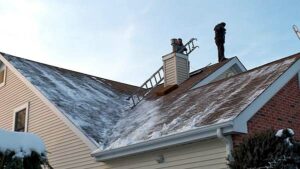It is critical to identify water damage during a home inspection to know if you want to continue forward with the transaction. After all, water damage can greatly reduce the value of any structure. This article provides practical tips for identifying water damage during a home inspection, ensuring that your home remains safe and sound.

7 Ways to Identify Water Damage During a Home Inspection
Spotting signs of water damage early can save homeowners significant repair costs and prevent potential health hazards.
1. Understand Common Causes of Water Damage
Before you can identify water damage during a home inspection, you need to know the most common causes. Water damage can occur for various reasons, such as plumbing issues—leaking pipes or faulty fixtures—are a frequent source of water damage.
Roof leaks, often caused by damaged shingles or inadequate sealing, can allow water to seep into the home’s structure. Flooding, whether from natural disasters or malfunctioning appliances, can also lead to significant water damage.
Knowing these causes helps you pinpoint potential problem areas during an inspection. For example, if a home has an older plumbing system, it’s essential to check for signs of leaks or corrosion. Similarly, homes in regions like Largo, where storms are common, should be inspected for roof integrity and proper drainage systems. Being aware of these common causes enables a more thorough and focused inspection, reducing the chances of missing critical signs of water damage.
2. Look for Stains and Discoloration
One of the most apparent indicators of water damage is stains and discoloration on ceilings, walls, and floors. These marks are often brown or yellow and can vary in size and shape. Ceiling stains may indicate a roof leak, while wall discoloration could result from plumbing issues within the walls.
It’s essential to inspect all areas of the home, including less visible spots like closets and behind furniture. If you live in the area, a Largo water damage company like Flood Pros USA can provide insights into common areas where water damage might occur based on regional weather patterns and building structures. In addition to visual inspection, checking for soft spots or sagging areas can also indicate underlying water damage. Identifying these signs early can prevent further deterioration and costly repairs.
3. Check for Musty Odors
Musty odors are a strong indicator of water damage and potential mold growth. These smells often arise from damp, enclosed areas where moisture has been present for an extended period. Common areas where musty odors may be noticeable include basements, attics, and bathrooms.
During an inspection, it’s crucial to note any persistent musty smells, even if visible signs of water damage aren’t immediately apparent. These odors can indicate hidden moisture problems, such as leaks behind walls or under flooring. Addressing the source of these smells is vital, as prolonged exposure to damp environments can lead to mold growth and associated health issues, such as respiratory problems.
4. Examine Walls and Ceilings for Texture Changes
Changes in the texture of walls and ceilings are another key sign of water damage. Bubbling, peeling, or cracking paint can indicate that moisture has seeped into the drywall or plaster. These texture changes occur when water weakens the adhesive properties of paint or causes the underlying materials to swell and warp.
It’s particularly important to inspect areas around windows, doors, and any exterior walls, as these are common entry points for water. In rooms like bathrooms and kitchens, where water usage is high, additional attention should be paid to wall and ceiling conditions. Detecting and addressing these texture changes early can prevent more extensive damage and maintain the home’s aesthetic appeal.
5. Inspect Flooring for Warping or Buckling
Different types of flooring can show signs of water damage in various ways. For instance, wooden floors may warp or buckle, while laminate may start to peel or swell. Tile flooring can also be affected if water seeps underneath, potentially loosening the tiles or causing the grout to crack.
During an inspection, walking over the entire floor area is essential to identify any soft spots or uneven surfaces. These can be signs of water damage beneath the surface. In carpeted areas, look for discoloration or a damp, spongy feel, which can indicate moisture issues.
6. Look for Mold and Mildew
Mold and mildew are common indicators of water damage and are near the top of the list of what to look for during a home inspection. There are serious dangers of mold that can pose serious health risks if not addressed. These fungi thrive in damp, humid environments, making bathrooms, basements, and areas with poor ventilation prime locations for growth. During a home inspection, it’s crucial to look for visible signs of mold and mildew, which often appear as black, green, or white spots on walls, ceilings, and floors.
Mold can also grow in hidden areas, such as behind wallpaper, under carpeting, or inside ductwork. Pay close attention to any musty odors, as they can signal the presence of mold, even if it’s not visible. It’s important to differentiate between mold and mildew, as mildew is typically easier to clean and less harmful. In contrast, mold can cause more significant damage and health issues, such as respiratory problems. If mold is found, it may be necessary to consult with a professional for proper removal and remediation, especially if it covers a large area or if the home has occupants with health concerns.
7. Check Windows and Doors for Condensation
Condensation around windows and doors can be a sign of water damage and poor insulation. When warm, moist air comes into contact with cooler surfaces, such as glass panes, it can condense and lead to water accumulation. This moisture can seep into the surrounding frame, causing wood to rot, paint to peel, and even promoting mold growth.
During a home inspection, carefully examine windows and doors for signs of condensation, which often manifests as water droplets or fogging on the glass. Also, check the frames for signs of water damage, such as discoloration, warping, or softness. In regions like Largo, where humidity levels can be high, ensuring that windows and doors are properly sealed and insulated is crucial to prevent moisture ingress. Addressing issues with insulation or seals can not only prevent water damage but also improve energy efficiency by reducing heat loss.
Key Takeaways
When buying a new house, it’s vitally important to identify water damage during a home inspection. What you thought might be your dream home could be a disaster waiting to happen. By being thorough and attentive to the various signs and using the right tools, homeowners can address potential issues early on. This proactive approach helps protect your investment and ensures a safe living environment.



